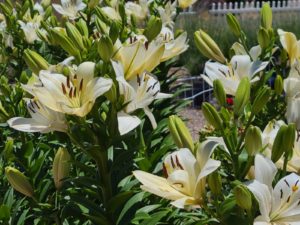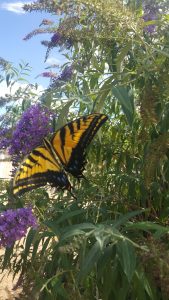January 28, 2015
Backyard Gardener
By: Jeff Schalau, Agent, Agriculture & Natural Resources
Raspberries are an easy to grow, very productive, perennial crop. A well-tended raspberry patch will often be productive for 10 to 15 years. They need full sun, but do not thrive in reflected heat such as a south or western exposure against a wall or building. In open windy areas, wind protection is important as dry winds can dehydrate and kill exposed canes.
Raspberries prefer a deep, well-drained, sandy loam soils and struggle on clayey soils and soils with poor drainage. Raspberries should be grown in a raised bed where clay soils exist. Incorporate two or three inches of compost to a one foot depth prior to planting. They will require regular irrigation which can easily be applied using soaker hose.
Raspberries are susceptible to Verticillium wilt and Phytophthora root rot, so avoid planting them in areas where raspberries, strawberries, tomatoes, peppers, eggplant, potatoes, or cucurbits have been grown in the past four years. To reduce virus potential, do not plant raspberries next to blackberries and purchase only certified virus-free nursery stock.
In the home garden, raspberries are generally planted in a hedgerow. Place plants in a row 12 to 18 inches apart with at least four feet between rows. Bare root plants should be soaked in water for a few hours before planting. Plant them in shallow holes large enough to spread out the root mass and set plant with the top root one to two inches below soil level. Water plants well after planting. Cut newly planted canes to 6 inches and apply frequent, light irrigation until the plants become established. Allow canes to fill in making the hedgerow. By hoeing or cultivation, routinely remove any canes (suckers) that come up outside of the hedgerow. For increased yields and reduced pest problems, keep the hedgerow narrow (about 8 to 12 inches wide).
While raspberries are perennial plants, their canes are biennial (living two years). Primocane is the term used to describe first year canes and floricane describes second year canes. When purchasing raspberry canes for planting, you will see descriptions for fall-bearing (primocane fruiting) and summer-bearing (floricane fruiting). I would recommend fall-bearing types for the mid- to high elevations of northern Arizona. These are easier to prune, do not require extensive trellising, and produce reliably each fall. The variety ‘Heritage’ does quite well in our climate.
Once established, raspberries need about 1 inch of water per week during blooming/fruiting. Depending on soil type, this may require irrigation once to twice a week. Raspberries work great with soaker hose or drip tape under a wood chip mulch.
Raspberries benefit from seasonal nitrogen fertilization. Fertilize all raspberries in the spring as growth starts and repeated in early June. For fall bearing cultivars, make a third application in August. Apply ½ to 1 cup of ammonium sulfate (21-0-0) or double this amount if using 10-10-10 per 10 feet of hedgerow. The fertilizer may be broadcast over the hedgerow area and watered in or placed in a band a foot to the side of the row. Raspberry pruning is simple with fall-bearing types – simply cut the canes to the ground each February or March (prior to initiation of growth).
Some insects and mites are pests of raspberries. These include grasshoppers, spider mites, plant bugs, and leaf rollers. Viruses can also infect raspberries over time. Simply remove the patch when the fruit becomes small and the patch is less productive. Start the new patch in another area of the garden using new, virus-free plants.
Visit the on-line edition for additional resources (see URL below). I have included: a couple of general publications that discuss raspberry culture; a publication discussing raspberry varieties; and a pruning video by my Utah colleague, Ron Patterson. I highly recommend looking at these additional resources with the on-line editions. They contain more detailed information which could not be included due to space limitations.



No comments.